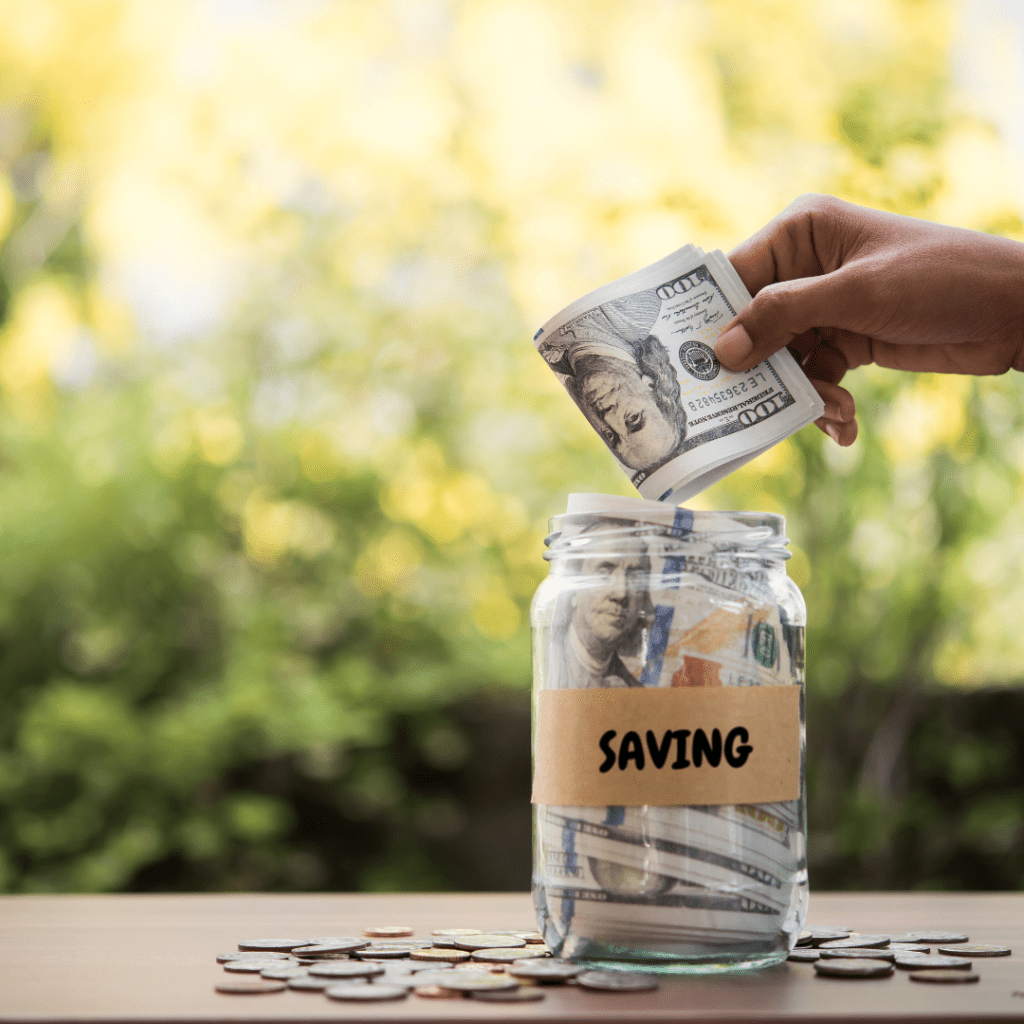How can I live on $500 a month after bills?
You paid all your monthly bills, and you realize that you only have $500 left in your bank account. Can you really live off $500 for your variable expenses for a whole month?
With good planning, you can easily live off $500 a month for groceries, gas, and other variable spending. The trick is to spend that money on needs and not waste it on wants that are not essential.
If you focus on your family values and really narrow down on what is important, you can manage to take care of your family and to save a little on a low amount after bills. If you want to learn more about family values on money, check out this article, “Value Based Spending & Changing your Money Mindset”.

How much money should be left over after bills?
If you have done a bare basic budget, where you list your income, monthly bills, and variable expenses like gas and groceries, you may be wondering if you have enough money left over after your bills. If you haven’t done a budget yet, check out this article, “The Super Easy Beginner Budget” to start one.
After you pay your bills and variable expenses, you will probably not have a huge amount of money leftover if you live on a lower income or a one income family. This amount may vary depending on if your income changes month to month.
There is no right answer to how much you should have left over after bills are paid, but the main thing is that you should have some money left over. If you have no money left over after your bills are paid, that means you do not make enough money or that you have a lot of “fat” in your budget.
Trim the “Fat” in your Budget
Fat in your budget simply means that you pay monthly for items that are not necessary. These typically fall into a “want” and not a “need”. For most families trying to save money or get out of debt, taking a hard look at your budget and getting rid of some of these items may give you more money to work with every month.
A recent article by CNBC states that 64% of Americans are now living paycheck to paycheck. This means that once the bills are paid, there is very little to no money left over. One of the biggest causes of living paycheck to paycheck is the increased costs associated with housing. This can be rent or mortgage expenses.
One way to get out of the paycheck-to-paycheck cycle is to trim the fat out of our monthly budget. Some changes may need to be made on a temporary basis and some changes will need to be more permanent.
To really trim your budget, you will need to get out all your bank statements and credit card bills, and really look at each of the charges that occur every month. Let’s look at some of the top things to trim out of your monthly budget!

What do you really need?
Sometimes when we look at a budget as a whole, it is hard to see what needs to be trimmed. We obviously can’t usually change our housing costs or our minimum debt payment amounts, but there is usually more to just those payments in our monthly bills.
In 2022, 85% of American households have a streaming service and the average household has 4.7 different streaming services. According to JD Power, the average household pays $47 a month on streaming services. Now if we temporarily cut down to just 1-2 streaming services a month, we can put an extra $20-30 a month back into our pocket.
Ideally, we would cut down to just one paid streaming service and start utilizing some free programming as well. For some ideas of free kid’s programming, check out this article, “14 totally free Roku Channels for Kids”. By switching to just one paid service a month, you could potentially save upwards of $40 a month. You can also rotate your paid service every couple of months if you get bored with your current service.
Similar to monthly streaming services, Americans spend an average of $273 on subscriptions monthly. This includes not just streaming, but covers things like monthly memberships to gyms (also at home services like Peloton), spas (massage, tanning, waxing, etc), and curated products boxes (like meal services, makeup/dog/toy boxes).
In general, there is almost always a cheaper option than a monthly membership service. For example, if you use a peloton membership, there are lots of free Youtube videos that offer a similar experience. If you have a membership to a spa service like tanning or waxing, you may want to temporarily switch to do it yourself options. If you are getting a monthly curated box of make-up, dog toys/treats, and kid’s toys, you can cut this cost down by just purchasing them individually or just skipping these “wants” for a few months.
Another monthly cost that adds up more than we think is payments made for free shipping like Amazon Prime and Walmart Plus. In order to avoid paying for shipping and for paying a monthly fee, most sites just require a minimum order of $35 or more. So instead of making purchases of just one or two items, save them up until you can qualify for free shipping.
Meal Planning is Essential
Grocery shopping seems to be one of the hardest areas to cut back on, but there are ways to be more efficient and spend less on groceries. Meal Planning is the key to cutting any household’s grocery budget!
Meal planning is basically making a plan for all meals that will be eaten by the family. According to this article by Fool.com, the average household spends $200 a month on meals prepared away from home like fast food, restaurants, and take-away places.
If we make a better plan to have food ready and eaten at home, we can save a huge amount of money! I like to plan one week ahead on our groceries, and I try to utilize 4 easy tips to save a lot of money on grocery shopping.

4 Tips to save money on groceries:
- Shop Grocery Ads First -Almost every grocery store puts their weekly sales ads online at the start of their sales. Where I live most sales start on Wednesdays and end on Tuesdays, so stores make their new flyers available on Wednesday mornings online. I look for the best deals and use that to start my meal planning.
- Utilize what is already in your pantry & freezer – Once I have some options picked out from the grocery store flyer, I start to look in my pantry and freezer for what could go with those items. If there is a really good deal on pita bread pockets, I am going to look for things I already have on hand to use with those pita bread pockets. I’m looking for things to put in the pockets and also to serve with them. For example: I may have some frozen ham that can be made into ham salad, and I already have a bag of potato chips and a can of mixed fruit that can be used as side dishes.
- Shop what is in season right now – More and more items are available all year round, but they aren’t always as cheap as when they are truly in season. For example, in springtime, strawberries are much cheaper even though you can buy strawberries almost all year round. I always base my produce buying on what is at the cheapest price because it is in season. (Usually, you will see these in the sales flyers as well). Another option is that if something is not in season right now, to try looking in the frozen or canned food aisles instead of buying them fresh at the higher price.
- Freeze what you can’t use right now– Almost everything you buy can be used later if frozen. There are not that many foods that you can’t prolong the life by freezing. If you find a really good deal on something, consider buying more than you need right now and freezing it, so you have it to use later at no additional cost. For example, if you buy a pack of bacon, but really only need a few pieces, consider only using the amount you need and freeze the uncooked bacon for later. If you notice your grapes are starting to wilt and you probably won’t be able to finish them soon, freeze them for a cool summer treat!
Just like with other areas of our financial planning, when we make a plan for meals, and buy when items are the cheapest, we will be able to make our grocery budget stretch further and further. If we pre-determine meals like breakfast, lunch, and dinner before we go grocery shopping and we use what we already have at home, we can spend a lot less at the store.
Emergency Fund
When you live paycheck to paycheck, odds are good you probably do not have an emergency fund. An emergency fund helps take the sting out of unexpected purchases like needing a new tire or a medical expense. It only takes a small amount every week to start making an emergency fund.
Check out this article, “What happens when you don’t have an emergency fund?” to find out more information about why you need a to start a fund and what is actually an emergency. You can also use a free printable tracker like this one “Rainy Day Savings Tracker“, to help you build an emergency fund!
If I only had $500 left over for the whole month after my bills are paid, I would be taking $50-100 to put towards an emergency fund. It would not take that long to build up $1000 to have on hand so I don’t have to go further in debt when unexpected emergencies come up.

Super Tight Budgeting
The great thing about budgeting is that it is a fluid exercise in financial management. Just because we have to trim down our budget to super tight now, doesn’t mean that as our situation changes that we may be able to add back in some wants.
The easiest way to loosen your super tight budget, is to pay off as much debt as possible. Once you pay off your debt, try to stay out of owing money and now you will have a lot more extra money after your monthly bills are paid.







